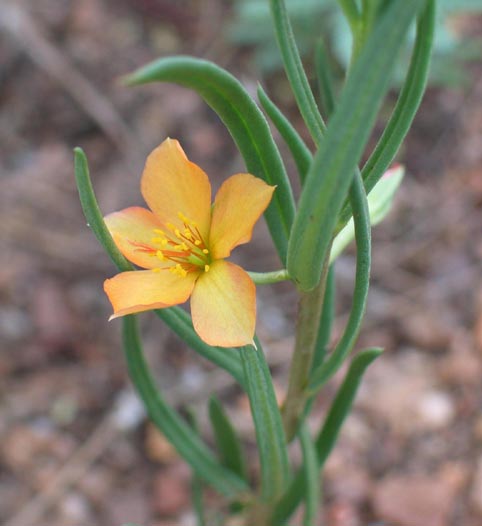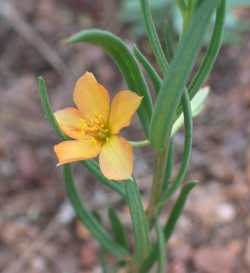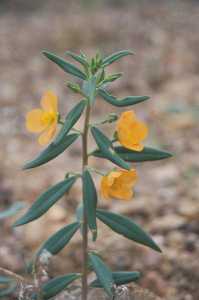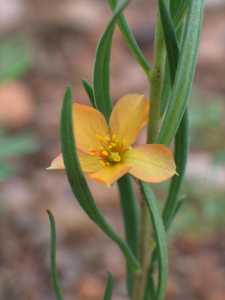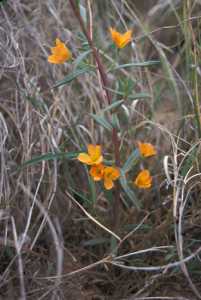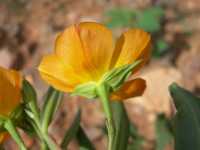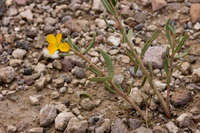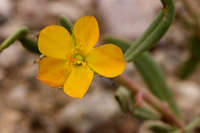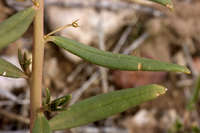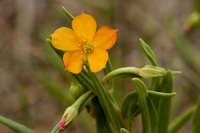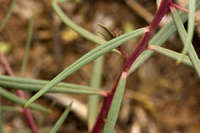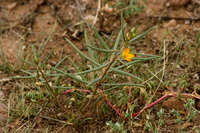Plants to 5 dm; roots woody-tuberous. Stems erect, simple or branching, slender to stout, sometimes suffrutescent. Leaves subsessile; blade narrowly planate, linear to narrowly lanceolate or rarely oblanceolate, to 6 cm, base attenuate. Inflorescences: flowers usually solitary, sometimes in 2-3-flowered cymules. Flowers: sepals deciduous, ovate, sometimes cuspidate, 5-10 mm; petals yellow or orange, sometimes reddish, rarely pinkish, obovate, 9-15(-25) mm; stamens usually 20-30; stigmas 3, linear; pedicel often recurving in fruit. Capsules ovoid to globose, 4-7 mm. Seeds with arcuate ridges, 1.2(-1.7) mm.
Flowering Apr-Nov. Washes, ravines, flats, dunes, slopes, benches, bluffs, ledges, often in grassland, scrub, or chaparral, sometimes along roadsides or in other disturbed sites, in sandy, gravelly, and rocky soils; 0-2100 m; Ariz., N.Mex., Tex.; n Mexico.
A cladistic analysis of chloroplast ndhF sequence data (W. L. Applequist and R. S. Wallace 2001) indicated that Phemeranthus aurantiacus belongs in the same clade as Talinum paniculatum (Jacquin) Gaertner and the two other species of that genus that were sampled, rather than in a separate and rather distant clade containing P. mengesii, the only other species of Phemeranthus included in the study. The molecular evidence, together with the planate leaves and extended stem of P. aurantiacus, which are anomalous in Phemeranthus, suggest that perhaps this species should be restored to Talinum. However, in fruit and seed characters, the chief morphological bases on which Talinum and Phemeranthus are distinguished, P. aurantiacus clearly belongs in the latter.
Talinum angustissimum often has been held separate from Phemeranthus aurantiacus (T. aurantiacum), but the supposed distinctions break down in a continuum of intergradation, the other extreme of which was described as T. whitei. The former extreme, centered in southern Arizona, has yellow petals, very narrow leaves, slender stems, and small, globose capsules; the latter, centered in southern Chihuahua and northern Durango, has orange to reddish petals, broad leaves, stout stems, and large, ovoid capsules. The name T. lineare Kunth, which properly applies to a species from central Mexico, has been misapplied to some collections of P. aurantiacus from Texas.
PLANT: Herbs to 5 dm tall. ROOTS woody tuberous. STEMS simple or branching, erect, sometimes suffrutescent.
LEAVES: subsessile; blades linear to lanceolate, rarely oblanceolate, basally attenuate, to 6 cm long.
INFLORESCENCE: lateral with flowers inserted singly or occasionally in cymules; pedicels often recurving in fruit.
FLOWERS: sepals ovate, sometimes cuspidate, 5-10 mm long, deciduous; petals obovate, 9-15(-25) mm long, yellow to reddish-orange; stamens usually 20-30; stigmas 3, linear.
CAPSULES: ovoid to globose, 4-7 mm long.
SEEDS: with arcuate ridges on sides, 1.2-1.7 mm long.
SYNONYMS: [Talinum angustissimum (A. Gray) Wooton & Standl.; T. aurantiacum Engelm.; T. aurantiacum var. angustissimum A. Gray].
NOTES: Desert scrub and grasslands, savannahs and open woodlands, in rocky soil, often granitic, sometimes calcareous: Cochise, Gila, Graham, Greenlee, Maricopa, Pima, Pinal, Santa Cruz, Yavapai cos.; 750-2000 m (2400-6600 ft); May-Oct; NM, TX; Chih., Coah., Dgo., N.L,. S.L.P., Tamp., Zac., Mex. Quite variable in size, flower color, and capsule shape, with a continuum of intergradation over its range. Plants from s AZ with petals yellow, leaves very narrow, stems short and slender, and capsules small and globose are an extreme form sometimes recognized separately as T. angustissimum.
REFERENCES: Allison Bair, Marissa Howe, Daniela Roth, Robin Taylor, Tina Ayers, and Robert W. Kiger., 2006, Vascular Plants of Arizona: Portulacaceae. CANOTIA 2(1): 1-22.
Duration: Perennial
Nativity: Native
Lifeform: Forb/Herb
General: Perennial herb to 50 cm tall, woody tuberous roots, stems simple to branching, erect, sometimes suffrutescent.
Leaves: Subsessile, linear to lanceolate, rarely oblanceolate, basally attenuate, to 6 cm long.
Flowers: Inflorescence lateral with flowers inserted singly or occasionally in cymes, pedicels recurving in fruit; sepals ovate, sometimes cuspidate, 5-10 mm long, deciduous, petals obovate, 9-15 mm long, yellow to reddish-orange, stamens 20-30, 3 linear stigmas.
Fruits: Ovoid to globose capsule, 4-7 mm long.
Ecology: Found in desert scrub and grasslands, savannas and open woodlands, in rocky soil, often granitic, sometimes calcareous; 2,500-6,500 ft (762-1981 m); flowers May-October.
Distribution: AZ, s NM, TX, south to s MEX.
Notes: Variable in size, flower color, capsule shape over the range. Recognized by being a hairless perennial; its showy orange to yellow flowers in which the petals come to a small point and emerge from leaf axils; 2 green sepals/flower; semi-succulent, round to semi-flattened, linear leaves with sunk-in mid-veins; and the enlarged tuberous roots. There is a recognized form P. angustissimum that has yellow petals, very narrow leaves, short slender stems, and small globose capsule; found in southern AZ.
Ethnobotany: Unknown
Etymology: Phemeranthus comes from Greek ephemoros, living for one day and anthos, flowers; while aurantiacus means orange, orange-yellow, or orange-red.
Synonyms: Talinum aurantiacum
Editor: SBuckley 2010, FSCoburn 2015


